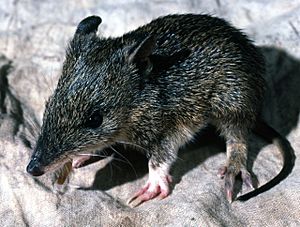Southern brown bandicoot facts for kids
Quick facts for kids Southern brown bandicoot |
|
|---|---|
 |
|
| Foraging adult | |
| Conservation status | |
| Scientific classification | |
| Genus: |
Isoodon
|
| Species: |
obesulus
|
| Subspecies | |
|
|
 |
|
| Southern brown bandicoot range | |
The southern brown bandicoot (Isoodon obesulus) is a small, furry animal that lives in Australia. It's a type of marsupial, which means the mothers carry their babies in a pouch. People in South Western Australia sometimes call it the quenda, a name from the Noongar language. These bandicoots are mostly found in the southern parts of Australia.
Contents
What Does a Southern Brown Bandicoot Look Like?
Southern brown bandicoots have a strong body, a short nose, and small, round ears. Males are usually bigger than females. A male can be about 50 cm long and weigh up to 1.2 kg. Females are smaller, about 40 cm long, and weigh up to 1 kg.
Their fur is rough and bristly. It's a dark greyish or yellowish-brown color, with a creamy-white or yellowish-grey belly. Their tail is quite short, about 13 cm long, and is brown on top and white underneath.
They have five toes on each foot. On their back feet, the second and third toes are joined together. All their toes have strong claws, which they use for digging. The female bandicoot has a pouch that opens towards her back. Inside, she has eight teats for her babies to feed from.
Where Do Southern Brown Bandicoots Live?
Southern brown bandicoots used to live in many coastal areas of Australia. Now, they are found in fewer places. There's a small group in the north-eastern part of the Cape York Peninsula in Queensland. All other bandicoots live in the southern half of Australia.
In New South Wales, they are rare. They mostly live in the far south-east and in two national parks north of Sydney. They are more common in Victoria, living along the coast and in mountains like the Grampian and Dandenong mountains, up to 1,000 meters high.
In South Australia, you can find them on the Eyre and Fleurieu peninsulas, the far southeast, and Kangaroo Island. In south-western Western Australia, their numbers are shrinking. However, they are very common in Tasmania, living almost everywhere on the island. They also live on Inner Sister Island but have disappeared from many other small Tasmanian islands.
These bandicoots like to live in open forests, scrublands, and heathlands. They especially like places with lots of plants and shrubs on the ground for cover.
Southern Brown Bandicoot Behavior and Diet
Southern brown bandicoots are active at night. They eat both plants and animals, making them omnivores. Their diet includes insects, spiders, worms, plant roots, ferns, and fungi. They don't drink much water because they get enough from the food they eat.
These bandicoots usually live alone and avoid each other. Their home areas are typically between 1 to 5 hectares. If two males meet, the stronger one might jump on the other's back and scratch it. Bandicoots have very thick skin, so this usually just makes them lose some fur, but they don't get badly hurt.
They spend most of the night looking for food. They use their strong sense of smell to find food by sniffing the ground. Then, they dig with their claws. If prey tries to escape, they chase it and hold it down with their front paws while they eat. During the day, they sleep in hidden nests made of shredded plants. Both male and female bandicoots have special scent glands between their ears. These glands might help them communicate with each other, and they get bigger during breeding season.
Southern Brown Bandicoot Reproduction and Life Cycle
Southern brown bandicoots can breed all year round, especially when there is enough rain. A female can have up to four litters of babies in a year. Pregnancy lasts less than 15 days, sometimes as short as 12 days. Usually, two or three babies are born, but sometimes up to five. Larger mothers tend to have more babies.
When they are born, the babies are tiny, weighing only about 350 mg. They stay in their mother's pouch for about 53 days. They stop drinking milk around 60 days old. They grow up quickly for marsupials. Females can have their own babies when they are four to five months old, and males can breed at six or seven months. In the wild, they probably live for about four years.
See also
 In Spanish: Bandicut marrón meridional para niños
In Spanish: Bandicut marrón meridional para niños




